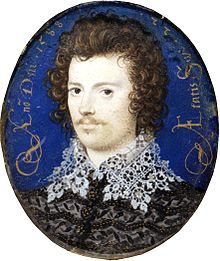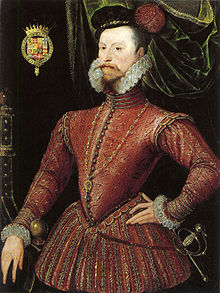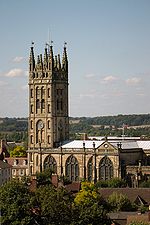Lettice Knollys
Lettice Knollys [ˈnoʊls], sometimes called Laetitia (born November 8, 1543 in Rotherfield Grays , Oxfordshire , † December 26, 1634 in Drayton Basset, Staffordshire ), was an English noblewoman and lady-in-waiting to Queen Elizabeth I. About her mother Catherine Carey was she is a granddaughter of Mary Boleyn , sister of Queen Anne Boleyn and thus a relative of Queen Elisabeth. According to some rumors, Lettice was the granddaughter of King Henry VIII.because her mother's paternity was controversial. From their first marriage came their famous son Robert Devereux, 2nd Earl of Essex .
Originally a favorite of the Queen and a well-known beauty at the court, she gained some notoriety through her secret marriage to Elizabeth's favorite, Robert Dudley, 1st Earl of Leicester . She was banished from court by the queen and never managed to reconcile her. She and her family were honored under King James I , but she was involved in legal disputes throughout her life. She died very old at the age of 91.
Life
Youth and first marriage
Lettice was the third of Francis Knolly's and Catherine Carey's sixteen children . She was named after her paternal grandmother. Sir Francis was an early Puritan who fled with his family to Basel and Frankfurt am Main during the reign of Maria I. Lettice may have been among the five children who were in exile with him, but it may also be that she stayed in Hatfield with Princess Elisabeth . After Elizabeth's accession to the throne on November 17, 1558, the family returned to England. Francis became treasurer of the royal household, his wife Catherine chief lady of the bedchamber and Lettice lady-in-waiting.

At the end of 1560, Lettice married Walter Devereux, Viscount Hereford . In the following year, Lettice probably withdrew from the court, as her payment as a lady-in-waiting was suspended. She lived with her husband at Chartley, Staffordshire , where Lettice had their first two children, Penelope and Dorothy, in 1563 and 1564 . Nevertheless, Lettice occasionally returned to court. There she flirted with Robert Dudley, Earl of Leicester , the Queen's favorite , in the summer of 1565 . The Spanish ambassador called Lettice one of the most beautiful women at court and a favorite of the queen. He also reported that Robert Dudley courted Lettice, allegedly to force a decision on Elisabeth. The Queen noticed it at once, and made scenes at Leicester for months. Lettice returned to Staffordshire where she gave birth to their first son, Robert, in November 1565 . Robert Dudley became the boy's godfather. She gave birth to Walter in 1570, followed by Francis in 1572, who died as an infant. In 1572 Devereux was made Earl of Essex .
In 1573 Devereux went to Ireland . Around 1575 Lettice possibly again got involved with Robert Dudley. When her husband returned from Ireland a scandal broke out as Lettice allegedly had given birth to two children to Leicester in Devereux's absence. Whether she actually already had an affair with Leicester at the time cannot be clearly proven, but it is possible. Leicester campaigned for Essex to return to Ireland, which was inevitable anyway. Shortly thereafter, Essex died of dysentery on September 22, 1576 and Lettice attended his funeral on November 26.
Marriage to Robert Dudley
As a widow, Lettice was allowed to marry Leicester. He hesitated for two years, however, as he rightly feared the queen's wrath. Lettice was also initially busy with securing her Wittum , since Devereux had left her hardly enough in his will to live on. Instead, she relied on friends to house her. She was therefore in lively correspondence with William Cecil, 1st Baron Burghley, and threatened her husband's employees with a lawsuit if they were not willing to compromise. While it is known that she hunted in 1577 and that her annuity was finally increased at the turn of the year, the two widow years are largely in the dark.
The two married on September 21, 1578 in front of only six witnesses in Leicester's Wanstead country house. Among them were Lettice's father Sir Francis Knollys, her brother Richard, Leicester's brother Ambrose and Henry Herbert, 2nd Earl of Pembroke . As the Witnesses later testified, Dudley had planned to marry Lettice since 1577. Allegedly, the wedding in the presence of the relatives was already the second celebration, as Lettice's father insisted on a ceremony in front of a notary instead of a secret wedding. Another guest, Humphrey Tyndale, later said that Lettice wore a “loose garment”, which was sometimes interpreted as a new pregnancy, although this has not been historically guaranteed. Despite everything, the marriage was an open secret. As early as November 1578, Thomas Radclyffe, the incumbent Earl of Sussex , told the French ambassador about this marriage. In retrospect, this marriage sparked rumors that Leicester and Lettice had poisoned Devereux.
It is not certain when Queen Elizabeth found out. However, in December 1579 it became a problem. Sir Edward Stafford, a contemporary, later reported that Elizabeth had believed Leicester was already married to Douglas Sheffield, the widowed Baroness Sheffield. Elisabeth never came to terms with Leicester's marriage. She banned Lettice from the court, which was generally avoided by society. The Queen also ranted Lettice (and her husband) in public at every opportunity. Lettice lived a secluded life for the next few years and called herself only Countess of Essex, although after the wedding she was entitled to the title of Countess of Leicester. According to reports, she was living with her father during this time, already heavily pregnant. In June 1581 the longed-for heir to Leicester, little Lord Denbigh, was finally born.
Little Robert Dudley was probably the only child of Lord and Lady Leicester. Although the French ambassador mentioned in 1582 that Lettice was pregnant with their second child, it is unknown what became of the child. In the summer of 1583, Lettice probably officially moved into Leicester House, as the Queen was reportedly angry that Leicester "was more open about its marriage than before". The French ambassador also noted after a joint dinner that Lettice had a great influence on her husband. Still, the marriage was likely to have been happy, with Leicester also generously caring for its stepchildren. So he tried, for example, his step-daughter Dorothy with the Scottish King James VI. to get married. This incident caused another fit of rage for Elisabeth, who angrily declared that she would forbid Jakob to marry “the daughter of this she-wolf”. It was not his only attempt to marry with the royal family. The captive Maria Stuart finally claimed that Leicester had tried to marry his son to little Arbella Stuart , but the boy died in July 1584, to the great grief of his parents.
In 1585 Leicester went to the Netherlands and became Governor General there . He wanted Lettice to come to him, and with wicked tongues asserting that she was planning to set off for the Netherlands with a larger retinue of ladies than the Queen possessed. When Elisabeth found out, she had a fit of rage and forbade Lettice to leave the country. Leicester authorized his wife to manage and rent out its lands in his absence. Her son Robert reported that his mother had fallen into mourning after his stepfather left again in June 1587.
Marriage to Christopher Blount
Leicester died shortly after defeating the Spanish Armada on September 4, 1588 at Oxford in the presence of his wife. In his will, he gave her generous consideration and appointed her executor. Despite receiving a large widow's pension, Leicester had left her so debts that its creditors claimed portions of their property. The problem was exacerbated by the fact that Leicester's illegitimate son Robert Dudley had inherited parts of their Wittum. Lettice was forced to sell part of her property in order to pay off Leicester's debts.
Ten months after his death, in July 1589, she married his equerry, Christopher Blount, which led to the defamation in the 17th century that she had poisoned Leicester. Her new husband was thirteen years younger than her and she always referred to him as a "friend", never as a husband, as he never called her his wife. Her son described Lettice's new marriage as "that unfortunate choice," but she herself said that marriage was the only option for a defenseless widow. She and Blount lived mostly withdrawn in Staffordshire, as they were mainly busy with the settlement of the debt-laden inheritance of the Earl of Leicester. In 1595 she retired to her seat at Drayton Basset, where she stayed until the end of her days.
Her retreat to the country may have been motivated by a refusal to remain at court without the Queen's forgiveness. She wanted, as she wrote to her son, "to gain the favor without which, as you know, I live there in greater shame". In 1597, Lettice was still quite confident, since "my friends there make me believe that Her Majesty is very much willing to listen to conditions for appeasement". Her son Robert Devereux was now a royal favorite and organized a meeting. In January 1598, ten years after Leicester's death, Lettice therefore hoped for forgiveness. After three attempts, which Elisabeth had broken off again out of nervousness, the queen received her long enough for Lettice to kiss her hands, but after that everything remained as before.
Later years
In 1599 Lettice tried to help her son, who was under arrest at the time. She sent Elisabeth a dress as a reconciliation gift, but her daughter Penelope wrote the letter so arrogantly that the Queen refused to accept the gift. Essex launched an unsuccessful attempt at rebellion against the Queen's “evil ministers” in February 1601, which resulted in his and Blount, who had now become Essex's right-hand man, being executed. Since both her son and husband were executed as traitors, their possessions fell to the Crown. This created new difficulties for Lettice, as her widow's inheritance was one of these properties. Her situation was desperate enough to say that Blount would have robbed her of her fortune. After the death of her eldest son, Lettice took care of the upbringing of her numerous grandchildren.
Even under the new King James I, she lived largely withdrawn in Staffordshire. Her grandson Robert Devereux was made third Earl of Essex by the king in the spring of 1603. The famous second Earl of Essex was also specifically rehabilitated. In addition, Jacob canceled her husband's remaining debts and her daughter Penelope became a favorite of Queen Anna . Your help became indispensable when Leicester's illegitimate son Robert Dudley claimed to be his father's legitimate heir. Allegedly he would have lived in bigamy with Lettice, which would have nullified all her claims to her widow's inheritance. She therefore allied herself with Robert Sidney , Leicester's nephew, and received support from Robert Cecil . In 1604 she sued Dudley for defamation and brought up no fewer than fifty-six witnesses to prove his illegitimacy. She eventually won the case, her grandchildren later re-involved in litigation by the Sidneys.
Lettice outlived all of her children by decades. She remained robust and healthy into old age, and at eighty-nine could still walk a mile a day. She died at the age of ninety-one on December 25, 1634, and was deeply mourned at court and in London. In her will she chose St. Mary's Church in " Warwick with my dear lord and husband, the Earl of Leicester, with whom I would like to be buried" as her burial place . Their request was granted, with Leicester's statue had to be moved so that Lettices also fit on the crypt. The grave is near the grave of her son, little Lord Denbigh.
progeny

With Walter Devereux:
- Penelope (* 1563; † 1607),
- ∞ Robert Rich, 1st Earl of Warwick
- ∞ Charles Blount, 1st Earl of Devonshire (this marriage was invalid)
- Dorothy (* 1564; † 1619),
- ∞ Thomas Perrot
- ∞ Henry Percy, 9th Earl of Northumberland , Diana Spencer comes from this line .
- Robert Devereux, 2nd Earl of Essex (1565-1601)
- Walter (1569–1591)
- Francis (* 1572; died as a child)
With Robert Dudley:
- Robert (* 1581; † 1584)
Lettice is one of the ancestors of Charles Darwin , Winston Churchill , Diana Spencer and Queen Elizabeth II.
Representation in popular culture
Lettice Knollys plays a supporting role in Philippa Gregory's novel The Queen 's Beloved. She is a granddaughter of King Henry VIII , though her mother Catherine Carey tries to cover it up. Shortly after her arrival at court, Elisabeth becomes jealous of Lettice's beauty. The girl quickly falls in love with Robert Dudley, but lets his rival William Cecil recruit her as a spy.
In the British miniseries Elizabeth I - The Virgin Queen played Sienna Guillory the role of Lettice Knollys. In this version, Lettice stays with Princess Elizabeth in England under the reign of Queen Mary and also accompanies her to the Tower of London . After Elisabeth's accession to the throne, Lettice serves her as a lady-in-waiting and falls in love with Robert Dudley. Tensions arise between her and Elisabeth as the Queen becomes jealous of Lettice's beauty after her smallpox disease and apparently only plays with Dudley. Lettice begins an affair with him and eventually secretly marries him. Elisabeth then banishes her from court. Lettice's son Robert Devereux, also Dudley's son in this version, fails to reconcile the two, whereupon Lettice bitterly turns away from him.
literature
- Simon Adams: Dudley, Lettice, Countess of Essex and Countess of Leicester (1543-1634). In: Oxford Dictionary of National Biography. 2004 Oxford University Press.
Web links
Individual evidence
- ↑ a b c d e f g h i j k l m n o p q r s t u v w x y z aa ab ac ad Simon Adams: Dudley, Lettice, countess of Essex and countess of Leicester (1543–1634) . In: Oxford Dictionary of National Biography. 2004 Oxford University Press. Online version January 2008 , accessed January 11, 2012.
- ↑ Lettice's father had a Latin calendar in which he entered the dates of birth of his children: Varlow, Sally: The Lady Penelope: The Lost Love and Politics in the Court of Elizabeth I London 2007 ISBN 0-233-00265-0 p. 21.
- ↑ Varlow, Sally: The Lady Penelope: The Lost Love and Politics in the Court of Elizabeth I London 2007 ISBN 0-233-00265-0 pp. 21-24.
- ↑ Calendar of… State Papers Relating to English Affairs… in… Simancas 1558–1603 ed. MAS Hume 4 vol. London 1892–1899 vol. I p. 472 [1] .
- Jump up ↑ Hammer, PEJ: The Polarization of Elizabethan Politics: The Political Career of Robert Devereux, 2nd Earl of Essex 1585–1597 Cambridge 1999 ISBN 0-521-01941-9 p. 13.
- ↑ “As the thing is publicly talked of in the streets, there can be no harm in my writing openly about the great enmity between the Earl of Leicester and the Earl of Essex, in consequence, it is said, of the fact that while Essex was in Ireland his wife had two children by Leicester… great discord is expected in consequence. “: Calendar of… State Papers Relating to English Affairs… in… Simancas 1558–1603 ed.MAS Hume 4Bde. London 1892-1899 Vol. II p. 511 [2] .
- ↑ Jenkins, Elizabeth: Elizabeth and Leicester London 2002 ISBN 1-84212-560-5 pp. 234-235.
- ↑ Jenkins, Elizabeth: Elizabeth and Leicester London 2002 ISBN 1-84212-560-5 pp. 280-281.
- ↑ Calendar of… State Papers Relating to English Affairs… in… Simancas 1558–1603 ed.MASHume 4Bde. London 1892-1899 Vol. III p. 477 [3] .
- ^ Hammer, PEJ: The Polarization of Elizabethan Politics: The Political Career of Robert Devereux, 2nd Earl of Essex 1585–1597 Cambridge 1999 ISBN 0-521-01941-9 p. 35.
- ↑ Wilson, Derek: Sweet Robin. A Biography of Robert Dudley Earl of Leicester 1533-1588 London 1981 ISBN 0-241-10149-2 p. 338.
- ↑ Jenkins, Elizabeth: Elizabeth and Leicester London 2002 ISBN 1-84212-560-5 pp. 361-362.
- ^ Hammer, PEJ: The Polarization of Elizabethan Politics: The Political Career of Robert Devereux, 2nd Earl of Essex 1585–1597 Cambridge 1999 ISBN 0-521-01941-9 p. 34.
- ^ Freedman, Sylvia: Poor Penelope: Penelope Rich. To Elizabethan Woman London 1983 ISBN 0-946041-20-2 p. 74.
- ^ Freedman, Sylvia: Poor Penelope: Penelope Rich. To Elizabethan Woman London 1983 ISBN 0-946041-20-2 pp. 121-122.
- ↑ Somerset, Anne: Unnatural Murder: Poison at the Court of James I London 1997, p. 12.
- ↑ Jenkins, Elizabeth: Elizabeth and Leicester London 1961 ISBN 1-84212-560-5 , pp. 368-369.
| personal data | |
|---|---|
| SURNAME | Knollys, Lettice |
| BRIEF DESCRIPTION | British nobles |
| DATE OF BIRTH | November 8, 1543 |
| PLACE OF BIRTH | Rotherfield Grays , Oxfordshire |
| DATE OF DEATH | December 26, 1634 |
| Place of death | Drayton Basset, Staffordshire |


